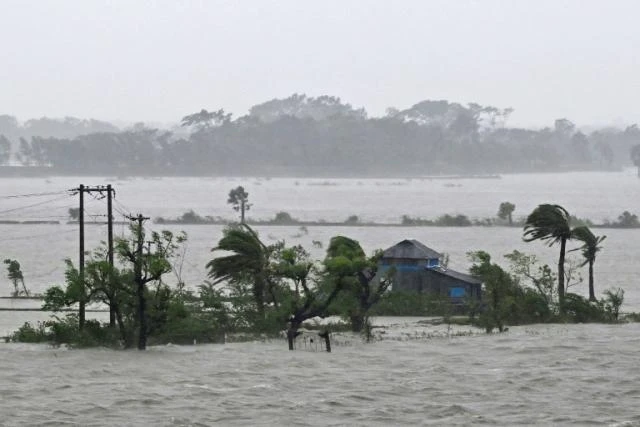Sixteen dead after cyclone batters Bangladesh and India

Stay tuned with 24 News HD Android App

Millions of people in low-lying areas of Bangladesh and India on Monday surveyed the tangled wreckage left by a powerful cyclone that killed at least 16 people, destroyed thousands of homes, smashed seawalls and flooded cities.
Winds and torrential rain still hammered residents as they tried to salvage what remained of their belongings, a day after Cyclone Remal made landfall with fierce gales and crashing waves.
"At least 10 people were killed in the cyclone" in Bangladesh, the country's state minister for disaster Mohibbur Rahman told reporters.
Some drowned, while others were crushed when their houses collapsed.
In neighbouring India, "at least six people" died, said Sumit Gupta, a senior government official from West Bengal state, including three who were electrocuted and others who were hit by debris.
Villages had been swamped by storm surges, tin roofs ripped off, trees uprooted and powerlines cut, an AFP reporter in the affected area said.
"A total of 3.75 million people have been affected... 35,483 homes were destroyed by the cyclone, and another 115,992 homes were damaged", Rahman said of the damage in Bangladesh alone.
'Extreme'
Cyclones have killed hundreds of thousands of people in Bangladesh in recent decades, but the number of superstorms hitting its densely populated coast has increased sharply, from around one a year to as many as three, due to the impact of climate change.
While many are used to the annual storm season, some said this cyclone was stronger and lasted longer than previous ones.
"This time the wind is extreme," said local businessman Uttam Kumar Das, 62. "It is also lasting longer than before."
Most of Bangladesh's coastal areas are just a meter or two (three to six feet) above sea level, making them vulnerable to storm surges.
The streets in Bangladesh's second largest city Chittagong were waist-deep in water after recording 240 millimeters (9.5 inches) of rain, the Bangladesh Meteorological Department said.
In the Indian city of Kolkata, residents sloshed through water up to their ankles.
Waves driven by the cyclone breached a major embankment on Bangladesh's Manpura island.
"The town protection embankment at Manpura was broken by the strong waves and heavy rains unleashed by the cyclone," said Showkat Ali, government administrator of hard-hit Barisal district.
"We are trying to rescue some 100,000 people."
At its peak, Remal's wind speeds hit 111 kilometres (69 miles) per hour, said Muhammad Abul Kalam Mallik, senior weather forecaster at the state-run Bangladesh Meteorological Department.
Around a million people in Bangladesh and neighbouring India fled inland seeking safety before the cyclone, with 250,000 remaining in concrete storm shelters in Bangladesh on Monday.
'Crying for food'
While scientists say climate change is fuelling more storms, better forecasting and more effective evacuation planning have dramatically reduced death tolls.
In India's West Bengal, the "cyclone has blown off the roofs of hundreds of houses" and "uprooted thousands of mangrove trees and electricity poles", senior state government minister Bankim Chandra Hazra told AFP.
"Storm surges and rising sea levels have breached a number of embankments," Hazra added. "Some island villages are flooded."
Sumita Mondal, 36, who hunkered down overnight away from India's coast, said she had fled with only what she could carry.
"My three-year-old son is crying for food," she told AFP by telephone.
But Mallik, the Bangladeshi weather expert, said the expansive Sundarbans mangrove forest -- where the Ganges, Brahmaputra and Meghna rivers meet the sea -- helped dissipate the worst of the storm.
"Like in the past, the Sundarbans acted as a natural shield to the cyclone," he said.
However, Abu Naser Mohsin Hossain, Bangladesh's senior forest official for the Sundarbans, said the storm surge had swamped crucial freshwater areas with salt water.
"We are worried," said Hossain. "These ponds were the source of fresh water for the entire wildlife in the mangroves -- including the endangered Bengal tigers."
